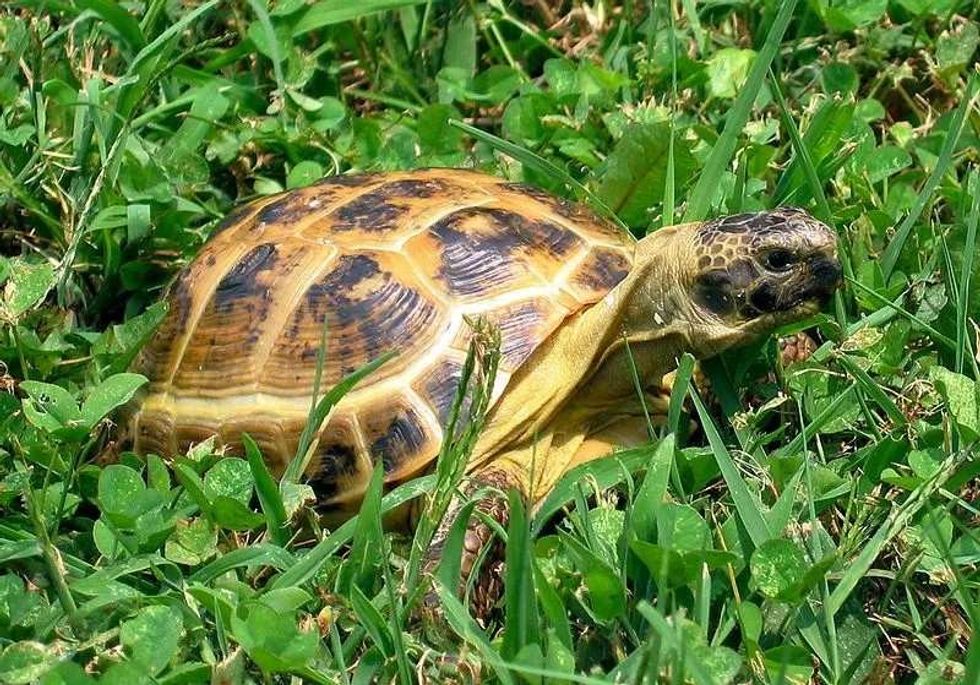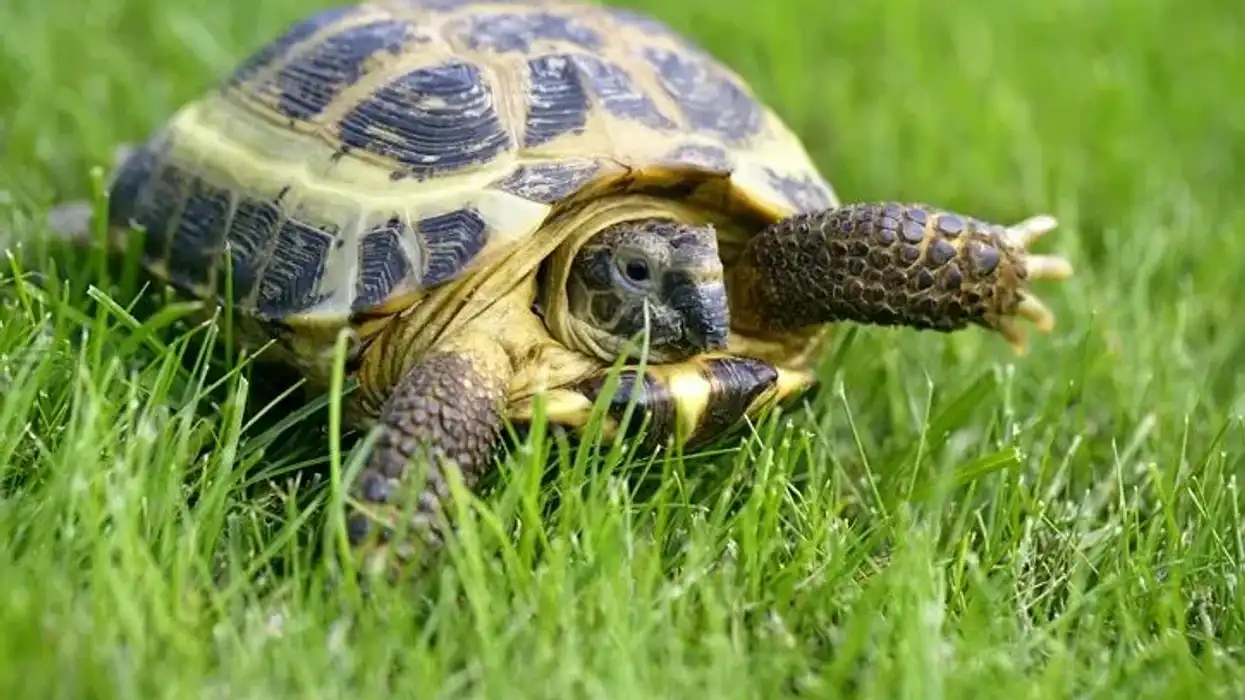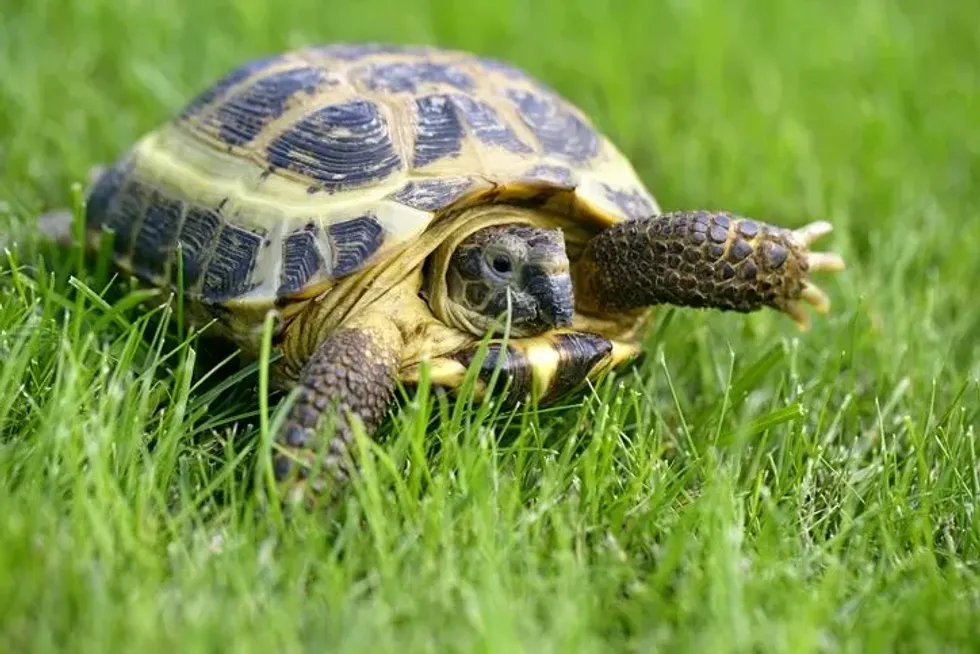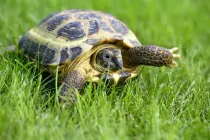Fun Russian Tortoise Facts For Kids

The Russian tortoise, (Testudo horsfieldii) is a small species of tortoises that are popularly found in Russia, along with other parts of central Asia.
Russian tortoises are categorized as Vulnerable on the IUCN Red List of animals because of human interference in their natural habitat and capturing them to sell into the pet market as these tortoises are one of the most commonly found species of tortoises in captivity.
The species spends as many as nine months hibernating in extreme weather conditions and can live more than 50 years in captivity if taken proper care of.
When they are born, they are about an inch in length and can grow 8-10 inches long when fully mature.
With females being slightly larger than males to bear more eggs. They make excellent pets as they are social and easy to tame, and are great pets for children.
If you like these true facts about the Russian tortoise, then you'll surely like these facts about the water snake and Olive Ridley sea turtle too!
Russian Tortoise Interesting Facts
What type of animal is a Russian Tortoise?
The Russian tortoise, (Testudo horsfieldii), more commonly known as the Horsfield's tortoise or the four-clawed tortoise, is a small tortoise species native to Russia and central Asia. They are rounder than other tortoises in comparison and have a flattened top instead of the more common domed shell.
They are light yellow in color with a hint of green and their skin color, including the entire head, is usually brown, dark gray, or tan.
What class of animal does a Russian Tortoise belong to?
Russian tortoises belong to the Reptilia class of animals. Reptiles are tetrapod vertebrates, i.e. creatures that have either four limbs or like snakes, are descended from four-limbed ancestors.
How many Russian Tortoises are there in the world?
No accurate record of the number of Russian tortoises can be found making it tough to keep a count of their population in the wild or in captivity as pets. Since the IUCN Red List classifies the Russian Tortoise as a Vulnerable species, we can assume that their population is dwindling and is going down.
Where does a Russian Tortoise live?
The Russian tortoise, (Testudo horsfieldii), or the Horsfield's tortoise, live in rocky desert areas in Russian and the entire central Asian region like Kazakhstan, Afghanistan, Pakistan, and Turkmenistan. In these regions, they can be found in large underground burrows where they hibernate for almost nine months in cases of extreme temperatures.
What is a Russian Tortoise's habitat?
Russian tortoises can be found in an extended region of Russia and central Asia. They inhabit dry, barren localities like rocky deserts and hillside to sandy or loamy steppes. Often being found on elevations of 5000 ft. They can survive in a variety of temperatures due to their solid build and stout body.
Throughout their range, the Russian tortoise habitat ranges from barren to arid environments with little to no rainfall and are commonly found in grasslands and deserts, with close water sources. When the temperatures get to an extremely high or low, they will hibernate in their burrows for months to conserve themselves.
Who do Russian Tortoises live with?
Like most other terrestrial tortoises, Russian tortoises are solitary animals that interact with other tortoises only when necessary for either food or mating purposes. They do not get lonely like humans or other animals.
Keeping multiple Russian tortoises in a single terrarium can be problematic as these species of tortoises are often territorial and might fight and bite others to assert dominance. However, they are not completely isolative in nature as they can sometimes be found grouped together in burrows.
How long does a Russian Tortoise live?
Russian tortoises, like most of the other tortoise species, have a slow metabolism rate which causes them to burn energy at a slower rate in comparison to smaller and faster animals. Russian tortoises can live for more than 50+ years with the proper care and attention.
The Russian tortoise diet of leafy greens and high fiber food helps extend their life span in the indoor enclosure and helps these reptiles outlive most of their reptile relatives by a huge age margin!
How do they reproduce?
With favorable conditions like a good diet and old enough age, Russian tortoises will mate. Mating takes place after the first few weeks from when the tortoises come out of hibernation. Males initiate the mating by circling around the female and bobbing its head.
After the mating process is over and the female is fertilized, she will be ready to lay eggs within a month. Some females will lay eggs in multiple clutches and some might not even lay eggs until the fall.
Females become very restless when they are ready to lay eggs, like pacing the perimeter of the pen and they may stop eating for a few days to a week.
Many even go as far as digging more nests. Females are particular about their nesting site section, however, after the eggs have been laid, they will take no further interest in the offspring.
What is their conservation status?
The IUCN Red List categorizes the Russian tortoise as a Vulnerable species of tortoises. Human interference in their native habitat has caused a lot of death and capturing them to sell them into the pet market has also made their population in the wild go down.
But with this species thriving in the domestic habitat their numbers are slowly and steadily increasing as breeders play a part in their breeding and increasing number.
Russian Tortoise Fun Facts
What do Russian Tortoises look like?
The Russian tortoises, (testudo horsfieldii) are one of the smaller species of the genus Testudo. And can be distinguished by a lack of movable plastron (bottom shell) hinge.
They possess sharp claws and defending themselves by retreating into their shell in cases of predator attacks. Their carapace (top part of the shell) can range from a tan to yellow to olive color, with black and brown markings. The plastron is either solid black or has brown or black patches.
The tail tip is bony and hard in males. The presence of four claws on each foot which makes them stand out from other tortoises is why they are often known as the 'four-toed tortoise'.

How cute are they?
Russian tortoises are as cute as they can get, especially babies! These small tortoises will show their affection towards their owners by following them around and even tolerate handling, eating directly from human hands, and will come to us when they see us.
How do they communicate?
Russian tortoises use a combination of visual and vocal clues along with smells to communicate with other tortoises. They also communicate through touch, either by exploring with their mouths, or bumping into things, or stepping on it to feel under their feet.
The study of tortoise communication is thought to be incredibly complex and studies show that pet Russian tortoises are much like the ones found in the wild, including their communication method.
How big is a Russian Tortoise?
Russian tortoises are a small tortoise species and are rather small in comparison to the other much bigger tortoises that can be found in the world. Russian tortoises have a size range of 5-10 in (12.7-25.4 cm). Females are larger than males 15-25 cm so they can accommodate more eggs.
How fast can a Russian Tortoise move?
Tortoises are slow creatures and a Russian tortoise average a speed of 8 km/hr!
How much does a Russian Tortoise weigh?
Russian tortoises (Testudo horsfieldii) are small tortoises and hence weigh as little as 0.5-2.5 lb (226.8-1134 g).
What are their male and female names of the species?
No particular name has been assigned to either gender of Russian tortoises.
What would you call a baby Russian Tortoise?
Baby Russian tortoises are called hatchlings. They use their egg tooth to break the eggshell and emerge. Hatchlings are vulnerable for the first few days.
What do they eat?
A Russian tortoises' natural diet consists of succulent vegetation including food like plants, twigs, flowers. Fruits are not recommended as a food choice. The best diet is one that comes as close as possible to their natural diet, which is low protein, calcium-rich, and high fiber.
Are they poisonous?
No, Russian tortoises are not poisonous. But like all reptiles, may carry salmonella bacteria in their GI (gastrointestinal) tracts. These bacteria are transmissible to people through bites and other interactions but don't cause trouble to the tortoises. Hence, always wash your hands thoroughly once you handle and are done with your Russian tortoise care procedure in their enclosure.
Would they make a good pet?
Russian tortoises, despite their small size, have a big personality and are one of the most popular species of tortoises kept as pets.
They are easy to care for and have a fairly long lifespan, often living more than 50 years with the best Russian tortoise care, a great enclosure, plenty of light and a diet of good-quality food as tortoises can get parasites from their food.
Did you know...
The personality of Russian tortoises is much like that of a dog, as they are social and friendly.
They might bite you! But, that's only because they might mistake your hand for food, so it's not their fault if you get bit. Just be careful when you're hand-feeding them.
Although they are popular as the Russian tortoise, they can be found in a large part of Asia and the Middle East and not just limited to Russia.
Despite their shell being big and bulky, these tortoises love to explore and climb different types of terrains.
They are diurnal, meaning they are active mostly during the day.
Russian tortoises have a strong tolerance to extreme temperatures.
Males have longer tails and longer claws in comparison to females.
On 18 September 1968, two Russian tortoises were the first living creatures to go into space as they were in the Soviet Union's Zond 5 spacecraft that circled the moon!
How to tell the age of a Russian Tortoise
Growth rings are the only indicators of growth that can help with determining the age of Russian tortoises. They don't necessarily grow one ring per year. Really old tortoises will have faded rings. These are rough ways of determining the age of the tortoise. But for an exact age determination, you need an exact hatch date.
Having your own Russian Tortoise
Buying one of these tortoises is inexpensive as they cost around $100-$200 USD and can be found in pet stores all around the world.
Russian tortoises will do best when kept outdoors in temperatures that do not fall below 40°F in winter! Russian tortoises should be kept in an ideal enclosure and will need at least a 30-gallon terrarium to thrive in it and should be taken outside in the natural sunlight whenever the temperatures permit.
Letting your Russian tortoise explore and play around in their playpens is a great way to get them their daily exercise.
Some points that you should add to your care sheet for your Russian tortoise enclosure should be:
A good amount of UVB light should be lit up for 12-14 hours a day as it helps in the metabolism of calcium of your tortoise as, without proper calcium production, these tortoises might fall victim to metabolic bone disease.
Temperatures of 70°-80° F during the daytime and 65°-75°F during nighttime.
Provide fresh water every day along with plants and other food sources.
Clean the enclosure every day.
Here at Kidadl, we have carefully created lots of interesting family-friendly animal facts for everyone to discover! Learn more about some other reptiles including sand lizard, or bog turtle.
You can even occupy yourself at home by drawing one on our Russian tortoise coloring pages.
We Want Your Photos!
More for You
Bachelor of Arts specializing in Journalism and Mass Communication, Postgraduate Diploma in Sports Management

Moumita DuttaBachelor of Arts specializing in Journalism and Mass Communication, Postgraduate Diploma in Sports Management
A content writer and editor with a passion for sports, Moumita has honed her skills in producing compelling match reports and stories about sporting heroes. She holds a degree in Journalism and Mass Communication from the Indian Institute of Social Welfare and Business Management, Calcutta University, alongside a postgraduate diploma in Sports Management.
Bachelor of Business Management

Yashvee PatelBachelor of Business Management
Yashvee has won awards for both her writing and badminton skills. She holds a business administration honors degree and has previously interned with social media clients and worked on content for an international student festival. Yashvee has excelled in academic competitions, ranking in the top 100 in the Unified International English Olympiad and placing second in an essay-writing competition. Additionally, she has won the inter-school singles badminton title for two consecutive years.
Disclaimer
1) Kidadl is independent and to make our service free to you the reader we are supported by advertising. We hope you love our recommendations for products and services! What we suggest is selected independently by the Kidadl team. If you purchase using the Buy Now button we may earn a small commission. This does not influence our choices. Prices are correct and items are available at the time the article was published but we cannot guarantee that on the time of reading. Please note that Kidadl is a participant in the Amazon Services LLC Associates Program, an affiliate advertising program designed to provide a means for sites to earn advertising fees by advertising and linking to Amazon. We also link to other websites, but are not responsible for their content.
2) At Kidadl, we strive to recommend the very best activities and events. We will always aim to give you accurate information at the date of publication - however, information does change, so it’s important you do your own research, double-check and make the decision that is right for your family. We recognise that not all activities and ideas are appropriate for all children and families or in all circumstances. Our recommended activities are based on age but these are a guide. We recommend that these ideas are used as inspiration, that ideas are undertaken with appropriate adult supervision, and that each adult uses their own discretion and knowledge of their children to consider the safety and suitability. Kidadl cannot accept liability for the execution of these ideas, and parental supervision is advised at all times, as safety is paramount. Anyone using the information provided by Kidadl does so at their own risk and we can not accept liability if things go wrong.
3) Because we are an educational resource, we have quotes and facts about a range of historical and modern figures. We do not endorse the actions of or rhetoric of all the people included in these collections, but we think they are important for growing minds to learn about under the guidance of parents or guardians.







